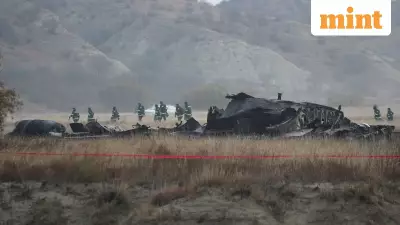
The agricultural district of Fatehabad in Haryana has found itself at the center of a major environmental and political firestorm. A dramatic and alarming rise in farm fires, used by farmers to clear crop residue, is casting a smoky pall over the region, triggering serious health concerns and intense scrutiny from state authorities.
The Alarming Data Behind Fatehabad's Farm Fire Surge
Official statistics reveal a deeply troubling trend. According to data from the Indian Agricultural Research Institute (IARI), Fatehabad district alone recorded a staggering more than 1,500 farm fire incidents in a short period leading up to a recent high-level review meeting. This number is not just a statistic; it represents a significant portion of the pollution plaguing northern India during the post-monsoon season.
The situation became so severe that it prompted direct intervention from the highest levels of the Haryana government. Chief Minister Manohar Lal Khattar personally chaired a critical meeting to address the spiraling situation. During this review, the performance of Fatehabad's local administration was heavily criticized for its apparent failure to curb the rampant practice of stubble burning.
Government Crackdown and Political Repercussions
In response to the crisis, the Haryana government has initiated a multi-pronged strategy. A central component of this strategy is the use of advanced technology for monitoring and accountability. The government is actively utilizing satellite data to pinpoint the exact locations of farm fires in real-time.
This data is not merely for observation. It forms the basis for strict action against negligent officials. The government has made it clear that it will not hesitate to suspend patwaris (revenue officials) and other field-level staff found responsible for areas where farm fires are detected. This move signals a significant shift towards holding local governance directly accountable for environmental violations within their jurisdictions.
The political heat is palpable. The district administration of Fatehabad is under immense pressure to demonstrate immediate and tangible results. The Chief Minister's office is demanding daily action-taken reports, turning the management of farm fires into a top administrative priority.
Why Farmers Resort to Stubble Burning Despite Bans
To understand the crisis, one must look at the root causes that drive farmers to burn crop residue. After harvesting paddy, farmers are left with a short window of just 20-25 days to prepare their fields for the next crop, typically wheat. Manually or mechanically clearing the leftover paddy straw is a time-consuming and expensive process.
Burning the stubble is, for many, the fastest and cheapest method available. Despite a official ban on the practice and the availability of government-sponsored machinery like Happy Seeders and Super SMS machines for managing crop residue, adoption remains a challenge. The high cost of operating this equipment, coupled with delays in accessing it, often pushes farmers towards the easier, albeit illegal, option of setting their fields ablaze.
The consequences extend far beyond field boundaries. The smoke from these fires is a major contributor to the dangerously poor air quality experienced across the Indo-Gangetic Plain. It releases harmful particulate matter (PM2.5 and PM10) and greenhouse gases, posing severe respiratory health risks to millions of people in the region.
As the pressure mounts, the Fatehabad administration is now scrambling to intensify its ground-level efforts. This includes increasing patrols, levying heavier fines on offenders, and ramping up awareness campaigns to promote alternative methods of stubble management. The coming weeks will be a critical test of whether governance and technology can effectively counter this deeply entrenched agricultural practice.





